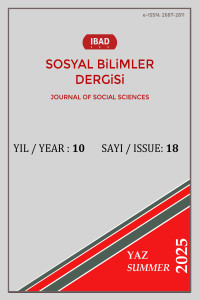Original Articles
Review Articles
Issue Editorial Board













Issue Reviewers




 0000-0002-7185-8480
0000-0002-7185-8480












 0000-0001-8170-6053
0000-0001-8170-6053












 0000-0002-7771-4146
0000-0002-7771-4146






 0000-0001-8593-4125
0000-0001-8593-4125

 0000-0001-9652-2089
0000-0001-9652-2089

 0000-0001-7625-0661
0000-0001-7625-0661


Aim & Scope
Aim
IBAD Journal of Social Sciences, a fully open-access online journal that publishes peer-reviewed research spanning all fields of the humanities and social sciences, including interdisciplinary studies. It aims to contribute to the exchange of knowledge in the fields of humanities and social sciences by publishing scholarly works that explore the social and cultural characteristics, historical contexts, and contemporary realities of Turks and Türkiye. The journal is committed to publishing articles related to Turks and Türkiye within the scope of humanities and social sciences.
Its target audience includes academics, researchers, professionals, students, and relevant professional and academic institutions with an interest in these topics. It is published semiannually in August and December.
Scope
IBAD Journal of Social Sciences publishes articles that take a scholarly perspective on the social and cultural characteristics of Turks and Türkiye, shedding light on their historical and contemporary realities, identifying challenges, and proposing solutions. In this context, it welcomes a wide range of theoretical, methodological, quantitative, and qualitative research that contributes to the literature. It particularly encourages studies that explore emerging ideas, address fundamental issues, or tackle major societal challenges, regardless of discipline. Interdisciplinary perspectives are also highly valued, especially when they contribute to the advancement of the humanities or social sciences.
Additionally, the editorial board is pleased to accept scholarly works in the humanities or social sciences authored by Turkish researchers or foreign scholars residing in Türkiye even if their topics are not directly related to Turks or Türkiye. This editorial stance is based on the rationale that a subject of interest to a Turkish researcher or a foreign scholar living in Turkey is likely to resonate with the interests of Turkish audiences as well.
The journal focuses on current issues and challenges, as well as past and future perspectives. It features original research and review articles, as well as scientific translations and book reviews.
Primary Topic Categories (including but not limited to)
|
|
1 cultural, social, and linguistic, but not biological. 2 in the context of areas such as education, law, policy, sociology, and economics. 3 including systems, management, financial analysis, and provision, as well as healthcare ethics and policy. 4 not including neuroscience.
Primary Keywords: Family sociology, Archaeology, Religion, Psychology of religion, Sociology of religion, Philosophical movements, Christianity, Communication, Media, Islam, Sociological issues, Television, Turkish language, Turkish literature, Turkish folklore, Turkish legal system, Turkish businesses, Turkish women, Turkish culture, Turkish architecture, Turkish music, Turkish art, Turkish political life, Turkish history, Turkish, Turkish education system, Turkish economy, Turkish public health, Turkish tourism, International relations, Judaism, etc.
IBAD Journal of Social Sciences ensures an efficient submission process for authors. With a rigorous peer-review system and a distinguished Editorial Board, it enables swift and fair publication decisions. Accepted papers are rapidly disseminated through a continuous online publication process, supported by innovative web technologies such as enhanced article templates and article-level metrics.
Author Guidelines
General Information
The article elements should be arranged as follows:
1. Turkish Title
2. Abstract (in Turkish)
3. Keywords (in Turkish)
4. English Title
5. Abstract (in English)
6. Keywords (in English)
7. Introduction
8. Main Text of the Article
9. Conclusion
10. References
- The main headings in the article should be capitalized and set in 12-point font, while subheadings should be in 11-point font.
- The article should be formatted in MS Word A4 size.
- Headers and footers should not be included.
- The font for the article should be Palatino Linotype.
Submission Preparation Checklist
Before submitting the manuscript, author(s) should check the following list.- Does your work align with the journal’s publication policy, aims, and scope?
- Have you included the author name(s), institutional affiliation(s), and email address(es)?
- Have you provided ORCID ID?
- In multi-author submissions, are the author names listed in the correct order?
- Has a corresponding author been designated?
- Have you specified the type of research?
- Does your manuscript include both a Turkish and an English title?
- Does it contain both Turkish and English abstracts?
- Have you included both Turkish and English keywords?
- Has the Copyright Agreement, Conflict of Interest, Author Contribution, and Financial Support Form been completed and signed by all authors?
- Do the in-text citations match the references listed in the bibliography, and vice versa? Are there any missing or incorrect citations, references, or attributions?
- Has the entire manuscript been carefully reviewed for grammar and scientific language?
- Is your manuscript formatted as a Microsoft Word document?
- Have you ensured that the manuscript has not been previously published or submitted for review to any other journal?
- If ethical approval is required for your study, have you obtained and included the necessary ethics committee approval documents?
Required Documents
Authors are required to submit the following documents when submitting a manuscript:
1- Author Contribution Form, Copyright Preference, Conflict of Interest, and Financial Support (Click to download)2- Full manuscript with author names (in Word format)
3- Full manuscript without author names (in Word format)
4- Ethics Committee Approval Certificate for applicable studies (See: Ethical Permission Policy)
5-Copyright Agreement Form (Click to download)Before publication, the final version of the manuscript will be re-evaluated using similarity detection software.
IBAD Journal of Social Sciences provides flexibility in terms of writing rules for our authors at the time of initial submission, as long as the manuscript is formatted properly and remains internally consistent. There is no requirement for a rigid structure before the peer review process, except for the essential components that should be included in the article. The journal does not impose restrictions on writing style, article length, or tables and figures. However, to facilitate the submission process, it recommends authors use the journal's template.
To access the template for submission, click here.
After your article is accepted for publication, a new template file will be sent to you, and you will be requested to edit your article according to APA 7 spelling rules. In this context, care should be taken to publish the accepted articles in accordance with the following spelling rules:
Main Text: The manuscript must be written in A4 size using MS Word, with the Palatino Linotype font, 11-point size, and single line spacing. The paragraph spacing should be set to 6nk before and after. Tables and figures should be formatted according to page size. For ease of the peer review process, the pages should be numbered.
Guidelines for Article Structure
The Introduction and Conclusion sections are mandatory in the main text.
To ensure academic integrity and consistency in the works published in our journal, we expect manuscripts to be structured according to the following steps. This framework should be applied not only to the full article but also separately to the Öz (Abstract in Turkish) and Abstract (in English) sections.Key Components of a Manuscript:
1. Contextualizing the Research Topic: Providing a broad overview of the subject or problem under discussion.
2. Clearly Defining the Problem and Research Objective: Clearly stating the specific issue being addressed and explaining its significance.
3. Literature Review: Summarizing previous studies related to the topic.
- Has this problem been directly addressed before?
- What are the most influential and recent studies in the field, and what findings have they presented?
- If the problem has not been directly studied, what are the closest related works?
- These questions should be answered, and appropriate references to the literature must be included.
4. Scientific Contribution of the Study:
- How does your research contribute to the existing literature?
- What gap in the literature does it fill?
- What does it introduce that has not been done before?
- This section should convince the reader of the originality and significance of your study.
5. Research Methodology and Implementation:
- A detailed explanation of how the study contributes to the literature.
- This section forms the core of the paper, requiring a systematic presentation of the theories, methods, and materials used.
- The main body of the manuscript should:
- First, establish the theoretical framework.
- Clearly define the methods and materials to be used.
- If necessary and relevant, provide background information on the historical context of the topic.
- Apply the selected theory and methods to concrete examples, demonstrating their implementation.
This structure will enhance the academic quality of the manuscript and help readers better understand the significance and contribution of the research.
Author(s) and Address: Author(s) names should be written in bold, with only the first letter of the first name capitalized, in 10-point size. The institution, country, and email address of the author should be listed in 9-point size. All authors must also include their ORCID ID.
Title:The title should be concise and accurately reflect the content of the paper. It must be written in 12-point bold font with capitalized first letters of each word. Efforts should be made to keep the title as short as possible. Main headings should also be in uppercase, 12-point, bold font.
Abstract: A concise abstract of the article must be included at the beginning, in both Turkish and English, with a length of at least 150 and at most 300 words. A +/-100 word variation is allowed under special circumstances. In all cases, the abstract should not exceed one page, as outlined in the template. Below the abstract, 3-8 keywords should be provided. The abstract must be written in 9-point font, without subheadings, citations, or references. It should encapsulate the introduction, development, and conclusion of the article.Keywords: Key words (3-8) should be in English and Turkish provided below the Abstract to assist with indexing of the article.
Figures: At initial submission, figures should be at good enough quality and high contrast to be assessed by referees, preferably incorporated with the manuscript text in a single Word doc or PDF, although figures can be supplied separately as JPEGs if authors are unable to include them with the text. Figures, tables and illustrations should not exceed 10 pages.
Conference Presentations: Articles that have been presented at a symposium or conference can be published, with the conference name, location, and date specified. For studies supported by research institutions or funds (such as BAP, TÜBİTAK, or the Ministry of Development), the supporting institution and project number should be included in the Acknowledgement section. If the work is derived from a thesis, this should also be noted here.
References: For Turkish articles, "KAYNAKÇA" should be used, while "REFERENCES" should be used for English articles. References should not be numbered, and if they exceed one line, the second line should be indented. The references should be written with single line spacing and paragraph spacing set to 6nk before and after.
Citation Examples in the Text:
One Author:(Akın, 2005, p. 15). (No page number is needed if referring to the entire work).
Two Authors:
If fully in parentheses: (Arıcı & Ungan, 2015, p. 17), otherwise: Arıcı and Ungan (2015, p. 17).
Three or More Authors:
(Aytan et al., 2021, pp. 20-25).
End of Text Reference Examples:For multi-author publications, use "&" between authors as shown in the two-author example. Further details for citations not specified here should remain consistent with the mentioned guidelines.
Journal Articles
The article title should be written in lowercase except for special words, the journal name in italics, volume in italics, issue in parentheses, and page numbers. The DOI should be included with the URL if available. If there is no DOI, online sources should include the full URL.
Kahya, H. (2018). Aday Türk dili ve edebiyatı öğretmenlerinin “edebiyat öğretmeni” kavramına ilişkin algılarının metafor yoluyla analizi. International Journal of Scientific Research, 3(1), 104-117. https://doi.org/10.21733/ibad.343188
Çeliköz, N. & Çeliköz, M. (2018). Öğretmen adaylarının medya ve televizyon okuryazarlık düzeyleri. International Journal of Scientific Research, 3(1), 262-274. https://dergipark.org.tr/tr/pub/ibadjournal/issue/31095/399539
Books
Book titles should be written in lowercase italics except for the first word, and the publisher should be listed without the city of publication.
Kahya, H. (2017). Karamanlıca bir çocuk dergisi: Angeliaforos Çocuklar İçün (1872). Grafiker Publishing.
Arıcı, A. F. and Ungan, S. (2015). Yazılı anlatım el kitabı. Pegem Akademi Publishing.
Book Written by a Corporate Entity
Turkish Language Association. (2005). Turkish Dictionary. TDK Publications. www.sozluk.gov.tr
Book Chapter
Başaran, M. (2019). The Ideal Teacher and Ideal Person in Nurettin Topçu. In A. F. Arıcı & M. Başaran (Eds.), The Ideal Turk (pp. 453-466). Turkish Literature Foundation Publications.
Translated Book
Crystal, D. (2016). What is linguistics? (Trans. A. Benzer). Pegem.Thesis or dissertationFollow the same format as books but in italics with the first letter capitalized. “Unpublished” should not be written.Başaran, M. (2007). İlköğretim 5. sınıf öğrencilerinin hikâye edici metin unsurlarına ilişkin tercihleri. Phd Dissertation, Gazi University, Ankara.Electronical referencesBlok3. (2024, March 8). Vikipedi. https://tr.wikipedia.org/wiki/Blok3 or Blok3. (2024). Vikipedi. https://tr.wikipedia.org/wiki/Blok3Encyclopedia Articles
Bezer, G. Ö. (2009). Seyfeddin Gazi I. In TDV Encyclopedia of Islam (Vol. 37, p. 31). Diyanet Vakfı Publications.Note: In multi-author publications, the format will follow that of two-author publications, with the use of "&" before the last author.Manuscript PreparationThe manuscript should be written in clear, concise and grammatically correct Turkish or English. The manuscript should be in MS Word program, with the Palatino Linotype font, 6nk after and before, 11 font size, single line spacing. The margins are set as follows: top = 55 mm, bottom = 40 mm, right = 40 mm, left = 40 mm. Pages should not be numbered.
Ethical Principles and Publication Policy
Research and Publication Ethics Policy
IBAD Journal of Social Sciences takes the following measures against published articles identified with plagiarism:
1. Immediately contacts the university to which the author(s) is affiliated and requests definitive action.
2. Removes the PDF copy of the article from the website and disables full-text access links. The phrase "Plagiarized Article" is added to the title of the article.
3. Deactivates the author's account and rejects all future article submissions for a period of 3 years.
For studies based on surveys and interviews, the following guidelines must be adhered to:
1) For research in all scientific fields that requires ethical approval, the ethics committee approval must be obtained, indicated in the article, and documented.
2) In research requiring ethics committee approval, information regarding the approval (committee name, date, and approval number) should be included in the methodology section, as well as on one of the first or last pages of the article, and information about the signed informed consent form should be provided in the article.
The journal may publish a special issue upon request by the Editorial Board once a year. The review process and rules for articles submitted for consideration in the special issue are the same as those for regular issues.
The Editorial Board may consider publishing a correction if minor errors that do not affect the findings, interpretations, or conclusions are identified in a published article. However, if there are serious errors or violations that invalidate the findings or conclusions, the article may be retracted. If there are suspicions that the authors have misused the research or publication, or if there is evidence showing the findings are unreliable, or if the institutions of the authors have failed to investigate the matter or if the investigation appears biased or inconclusive, the editors may consider publishing an expression of concern. In cases of correction, retraction, or expression of concern, actions will be taken in accordance with Committee on Publication Ethics (COPE) guidelines.
Since its first issue, IBAD Journal of Social Sciences has adhered to universal publishing standards. The Editorial Board of IBAD Journal of Social Sciences is composed of experts in their fields. The members of the Editorial Board are selected based on their expertise in various disciplines within the social sciences. The Editor-in-Chief may send articles to guest editors, who are faculty members not part of the Editorial Board, for review if the subject of the article requires it.
In IBAD Journal of Social Sciences, if any unethical behavior is observed by editors, reviewers, or authors during the evaluation process or if any unethical situation is encountered in early stages or in a published article, we encourage you to report it to ibadjournaleditor@gmail.com. This will help enhance the quality of our publication. Readers who detect significant errors or inaccuracies in a published article or have any concerns regarding editorial content (such as plagiarism or duplicate publications) can report the issue by emailing ibadjournaleditor@gmail.com. We view complaints as an opportunity for growth and welcome your feedback. Our goal is to respond promptly and constructively. Ethical complaints related to published articles will be investigated, even if a significant amount of time has passed since the publication date. The author will be contacted, and information regarding the complaint or allegations will be provided. If a violation of ethical standards is identified during the investigation, a correction note will be published addressing any publication error, inconsistency, or misleading information.
Authors submitting to IBAD Journal of Social Sciences are expected to consider the feedback and suggestions provided by reviewers and the Editorial Board. If they disagree with certain points, they have the right to submit a reasoned objection. Peer review reports are stored digitally in the DergiPark system. By submitting a manuscript to the journal, authors are deemed to have accepted the journal’s peer review policies and procedures. (See: Review Process)
The Editorial Board reserves the right to make minor revisions that do not alter the essence of an accepted manuscript. If deemed necessary, the Board may also appoint a guest field editor. An author may submit only one manuscript at a time, including co-authored works. Additionally, an author may have no more than one paper published in a single issue. Once a manuscript is published, the author may submit a new manuscript for the following issue.
Editorial Board members are also permitted to submit manuscripts to the journal. However, in such cases, they do not participate in any stage of the editorial process for their own submissions. While the manuscript is undergoing peer review, its authors who also serve as editors have their editorial roles suspended to prevent access to the review process. This ensures the integrity of the double-blind peer review system. The journal ensures that in the last two issues, no more than 25% of published research articles have at least one author who is an editor, Editorial Board member, or reviewer.
IBAD Journal of Social Sciences is published twice a year, in August and December.
Price Policy
IBAD Journal of Social Sciences utilizes paid services for digital publishing, graphic design, typesetting, participation in international indices, and other processes. Therefore, in accordance with Article 44 of the Frequently Asked Questions on the Associate Professorship Criteria by the Interuniversity Board (ÜAK), authors submitting articles are required to pay a participation fee after submission. This fee must be paid in order to initiate the review process for the submitted articles. The fee is collected regardless of whether the article is accepted or rejected. Payment of the fee does not guarantee the acceptance of the article for publication. The acceptance or rejection of the article is determined by the editorial board based on the reviewer reports. Authors whose submissions are rejected by the reviewers will not be refunded the fee paid. By submitting an article to the journal, authors are deemed to have accepted these terms.
This journal is a member of and subscribes to the principles of the Committee on Publication Ethics. |
IBAD Journal of Social Sciences I (online) ISSN 2687-2811

